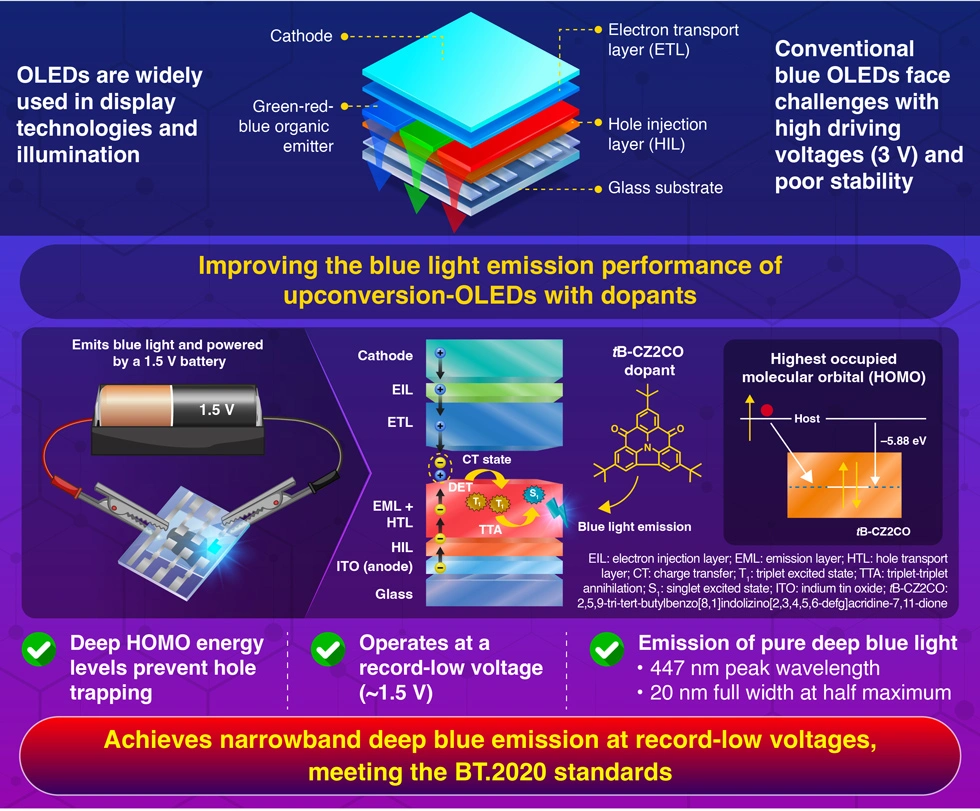A deep blue organic light-emitting diode (OLED) developed by researchers at Science Tokyo operates on just a single 1.5 V, overcoming the high-voltage and color-purity problems that have long limited blue OLEDs. The breakthrough was achieved by introducing a new molecular dopant that prevents charge trapping, a problem that previously hampered the performance of low-voltage OLEDs. The resulting device produces sharp blue emission that meets BT.2020 standards, paving the way toward brighter, more energy-efficient displays.
Blue Organic Light-Emitting Diodes (OLEDs) Deliver Pure Deep Blue Light at 1.5 V

Shui et al. (2025) | Advanced Optical Materials | 10.1002/adom.202501576
Organic light-emitting diodes (OLEDs) are widely used in large-screen televisions and smartphone displays. Yet, among the three primary colors needed for full-color technology-red, green, and blue-the blue emitters remain the most challenging. They demand higher energy, often requiring driving voltages above 3 V, and suffer from limited long-term stability.
Now, a research team led by Associate Professor Seiichiro Izawa of the Materials and Structures Laboratory at Institute of Science Tokyo (Science Tokyo), Japan, has achieved a breakthrough in the field of OLEDs. The research team also included Professor Yutaka Majima, doctoral students Qing-jun Shui and Hiroto Iwasaki, and Master's student Daiki Nakahigashi, all from the Frontier Materials Research Institute, Science Tokyo. They developed a deep blue OLED capable of being powered by just a single 1.5 V battery. "This achievement represents a major advance in reducing the voltage required for high-purity deep blue emission close to next-generation display standards," says Izawa. The study was published online in the journal Advanced Optical Materials on September 30, 2025.
The device is based on upconversion-type OLEDs (UC-OLEDs), which generate light through a process called triplet-triplet annihilation (TTA). In conventional OLEDs, light is produced when electrons and holes meet in the emission layer, forming a charge-transfer state that excites a fluorescent dopant. UC-OLEDs reduce the operating voltage by shifting this process: electrons and holes form a charge-transfer state at the interface between the hole transport layer and the electron transport layer. This energy is then transferred to triplet excitons in the host material, and when two triplets annihilate, they create a higher-energy singlet state. That singlet then excites a dopant molecule, which emits light.
However, earlier versions of UC-OLEDs struggled with color purity. They often produced sky-blue light with a broad spectrum. The problem stemmed from the choice of dopant and its tendency to trap holes. In UC-OLEDs, there are no free electrons available to neutralize these trapped charges. As a result, trapped holes accumulate, reducing the mobility of other holes and preventing efficient recombination.
To overcome this, the team tested a range of blue-emitting dopants. They began with the DABNA family of materials, known for their narrow emission. In practice, however, these dopants slowed down charge movement and raised the operating voltage by 1 to 2 V. This occurred because DABNA has a higher highest occupied molecular orbital (HOMO) level (the energy level for holes) than the host material, causing the molecules to act as traps that block hole transport. However, they noticed that when the traps were shallow enough, trapped holes could escape via thermal energy.
Building on this insight, the researchers introduced a new class of dopants: the QAO family. QAO, short for quinolinoacridine-dione, belongs to a group of multi-resonance thermally activated delayed fluorescence molecules. Importantly, their HOMO levels are lower than those of the host materials, which prevents them from trapping holes and ensures smooth charge transport.
Within this family, one material proved especially promising: tB-CZ2CO, a QAO derivative with bulky tert-butyl side groups. Devices containing only 0.5% of this material produced sharp, deep blue emission at 447 nm with a narrow bandwidth of 20 nm, meeting the demanding BT.2020 color standard for wide-gamut displays.
By analyzing how the molecular structure and electronic properties of dopants affect charge transport and trap formation, the researchers established clear design rules for selecting dopants that produce narrowband blue emission. "Overall, our findings not only elucidate the complex doping mechanisms in UC-OLEDs but also establish a rational framework for designing energy-efficient, high-color-purity blue UC-OLEDs with broad implications for next-generation optoelectronic applications," says Izawa.
This work addresses a long-standing challenge and paves the way toward sharper, more energy-efficient displays with lower power consumption in large-screen televisions, smartphone displays, and other OLED-based technologies.
Reference
- Authors:
- Qing-Jun Shui1, Hiroto Iwasaki1, Daiki Nakahigashi1, Yutaka Majima1, and Seiichiro Izawa1,2*
- Title:
- Narrow-Band Deep Blue Emission in Organic Light-Emitting Diode at 1.5 V
- Journal:
- Advanced Optical Materials
- Affiliations:
- 1Materials and Structures Laboratory, Institute of Science Tokyo, Japan
2JST PRESTO, Japan






